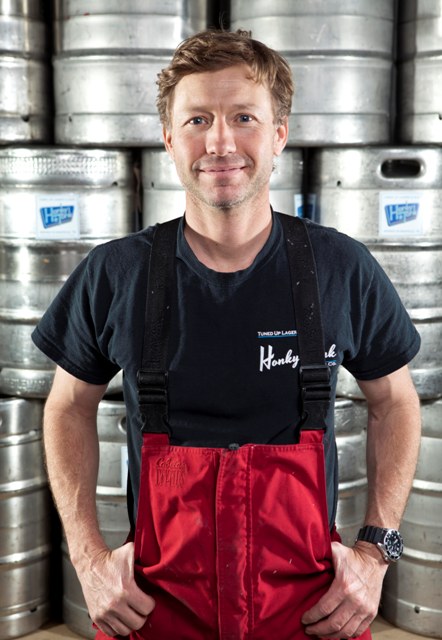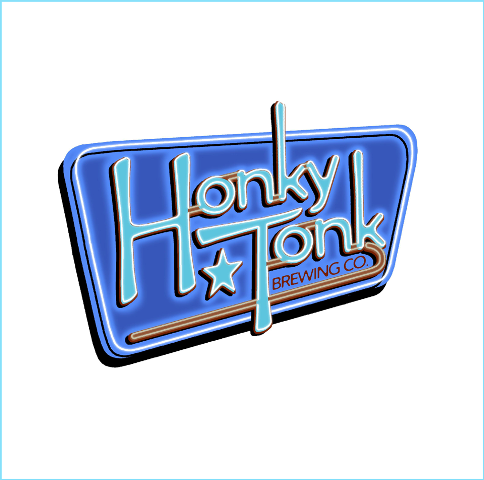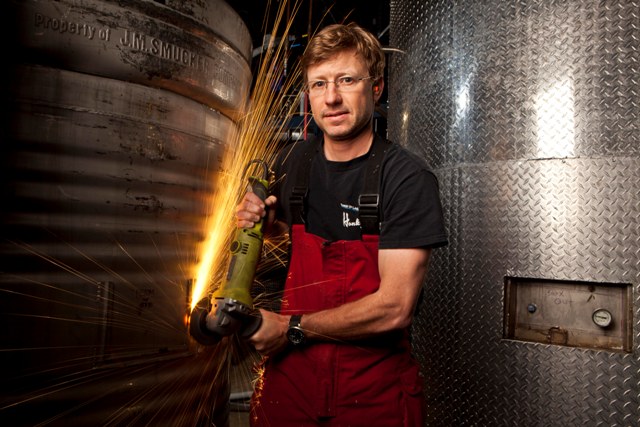Per Matt
Scott Swygert is an incredible multitasker. Not only is he the founder of Honky Tonk Brewing Co. but as the only full-time employee of the brewery, he also sells, brews, delivers, cleans, welds and does anything else necessary to promote his craft beer.
In my interview with Mr. Swygert, we discuss the Honky Tonk Brewing Co. origins, preview his upcoming seasonal beer and highlight the musical acts performing at his brewery.
How did you get your start in the alcohol industry?
– “I started as a homebrewer, as most people do. My previous experience in the beer world was delivering Budweiser kegs, one summer. Other than that, I didn’t have experience in food and beverage or alcohol. I was a homebrewer and then came up with a business plan at the same time everybody else did, in Nashville, which was three or four years ago, when it looked like there was virtually no beer in Nashville other than Yazoo and a couple of the brewpubs. I think my timing was about the same as everybody else’s: The market was ripe for more good beer.”
“I lived in Colorado, Oregon, Wyoming and Alaska for probably 15 years combined. Out there, you kind of soak up the beers. It’s part of the culture. Then you’re in Tennessee and you look around and wonder, ‘Where is all the beer?’ I think that was the main impetus for me trying to get into it. I saw what I thought wasn’t enough local beer.”
Were you ever in a homebrewing club?
– “I have since befriended most of the people in Music City Brewers and the Mid-State Brew Crew, but I wasn’t an active member when I was homebrewing. By the time I was on their Facebook pages, I think I was already raising money for this brewery. They’re nice guys. They run good shows and events.”
What were some ingredients you experimented with, as a homebrewer?
– “My first brew was an Amber Ale. It’s not that different from the one that I brew now. It turned out pretty well. I had problems like most people do: Keeping the hops out of the fermentor and things like that. It was a flavorful beer. I was pretty impressed. The first batch was all grain and made a drinkable beer out of it. It was easy to get hooked, after that.”
“One of the funnier ones happens at least once, to everybody. I went to a big beer, like an 8% stout of some kind, and blew the top off the fermentor in the middle of the night. I woke up the next morning and the whole ceiling in the bathroom was coated in black fermentor juice. It took a couple of days to get that off the ceiling. I only ruined one batch of beer. I’ve been thinking about it for five years, now.”
“My theory is, now, that the water may have had chloramine in it. I’ve heard that it’s impossible to get chloramine out of your water. You can’t even filter chloramines out. You can filter chlorine, but this taste was so brutally toxic, I actually think it came out of the water in Williamson County and not the brew. I talked to the water guy around that time about the pH, because the pH was really high — it was, like, 8. He ran a test but didn’t tell me what he was using. I think some water districts dose their water with a certain chlorines during certain times of year, if they can’t get rid of some algae, they’ll try different things.”
“Homebrewing’s fun. I haven’t done it in a long time, now. Once I started construction on the building, I didn’t have time to make beer. I probably took a 15-month hiatus from brewing. I didn’t brew a single thing, once I got the lease on the building, until I brewed the first batch in the building.”
When did you get the lease for your brewery?
– “It must have been June of 2013. We’re coming up to two full years.”
When did you open the brewery?
– “We started brewing in late September and opened the doors to the Tap Room in October of 2014. I had one beer on tap. Then two weeks later, we had two beers on tap. For a while, we probably just had two on tap. I think I would get a better batch and then I’d take the first one off. The first two or three didn’t hit the gravities, because I didn’t know how to measure the water in the kettles. I was just missing the gravities. I was trying to brew five or six barrels of beer in a 24-barrel kettle. You couldn’t see how much water you had in there. I finally figured out how to use a dipstick and did the math on what’s in the cone. Now, I still use that. If you make a 150-gallon brew and you miss it by 20 gallons, you’re messing up the beer. So, I’ve got it fixed.”
How did you pick the location for the brewery?
– “Really, it all came down to the number. You’re always trying to get the best of both worlds: You want a retail storefront for a brewery to have a brewpub in the front and warehouse square footage in the back for your wholesale operations. The two really don’t exist very well together, at least from the financial perspective. It’s really hard to find one that works for both. This one works for both, but we’re going to spend more energy to create this retail space that I would have in other locations. We’ve got a great production brewery site and a slightly less attractive retail spot. I’m going to keep knocking on doors in the MetroCenter business park until we fill it up, consistently.”
What is your flagship beer?
– “It’s one of the two IPAs that we’re making right now. I think we sell an equal amount of the Amber as the other two beers, in the Tap Room, but the bars don’t have as much love for the Amber. I don’t think they see it, yet. I might be able to convince them that they can sell a lot of that beer. It’s our ‘barbecue beer.’ The local barbecue restaurants have picked up that it pairs well with barbecue. It goes down really well. At beer fests, if people aren’t IPA fans, they’ll come back for two or three of the Amber.”
“We’re making the two IPAs year round, right now. One’s a West-Coast IPA, so it’s very bright, light-colored beer with a lot of hops in it. It’s dry hopped for at least seven days. It’s been a great seller at growler-fill locations. I think people start going to those wondering what they want to drink at home on a consistent basis. And then this Wheat IPA is a beer that wasn’t in our plan, originally. It was sort of an accident. People liked it, so we kept making it. ‘Wheat IPA’ might be a little bit of a misnomer because it’s not quite bitter enough in IBUs to be in an IPA category, but I want to get the recognition for dry hopping it. It’s really a dry hopped wheat pale ale. That’s our best on-premise-drinking beer, for pints. That one’s selling pretty well.”
What kind of beer trends are you noticing?
– “I think IPAs are going to keep going, forever. The world spent 250 years drinking pilsners. Now, we’re going to spend the next 200 years drinking IPAs. I like lagers and pilsners, we’re going to make those too, but IPAs are not a fad. They’re not going away. People like hops. There’s a million ways to present the hops. You can dry hop, you can not dry hop, you can mix it in a darker beer, like a hoppy porter or hoppy stout, or you can make really bright-colored West Coast IPAs, which we are making. We actually make an East Coast IPA, too, that’s a little more malty, a little sweeter and a little darker. It’s not a dark beer; it’s more amber colored. That one is a great seller, too, I just felt like our first offering in the IPA category ought to kick ass. We’ll bring back the East Coast one, too.”
“I think sours are working. I don’t have the experience or the patience for it, right now, to mix it into our offerings. Barrel aging will continue, but I don’t think it’s anybody’s go-to beer.”
Are those types of beers you’ll try at some point?
– “Absolutely. Just not right now. I don’t have the manpower or the patience to mix it in every day. I’ve got enough on my plate. I want to have five year-round beers plus a seasonal, by late spring, with the equipment I have and the way I’m set up. If I can keep up with five year-rounds, I’ll be happy with that.”
What are you intended year-round beers?
– “I’m going to keep making the Wheat IPA, Amber Ale, West Coast IPA and then we’re going to brew the lagers: A classic American pilsner, a Maibock (hoppy, strong lager) and an American Wheat beer. Out of those three, two of them are going to shake out to be year-rounds or mostly year-round, like 10 months of the year. The market’s going to tell me what people want to keep buying.”
What’s your upcoming seasonal beer?
– “The Black IPA’s malt build is pretty much based on our West Coast IPA, plus the addition of black malts, but I changed the hops. It’s going to be more resinous and maybe piney. We’ll see how that goes. It’s a first-time brew for me.”
Do you plan on brewing dark beers year round or seasonally?
– “For me, right now, it’s seasonal. It may be our sixth year-round in a year, so check back, but I’m not pushing stouts or porters. I did a brown ale that was my seasonal in December. It was an oatmeal brown that sold out relatively quickly. That was a great beer. That’s been our darkest, until the Black IPA, which is really a hoppy beer, not a dark, sweeter or malty beer. We’ll bring the brown back. That’s a given, for us.”
Why do you think Nashville has a booming craft-beer scene?
– “I think it was so behind the times, that it couldn’t do anything but boom. The Southeastern United States, in general, was so far behind Colorado, California and Oregon that it couldn’t do anything but boom to catch up. We’re probably just barely getting back to the 50 percent mark would be for the country on breweries per capita or probably not even for consumption. I bet, if you look at the state of Tennessee, it’s probably still so lopsided toward macro, there’s plenty of room for consumption to grow.”
“Nashville is still budding for craft beer. I’m finding people want it, but the bars still aren’t turning their backs on macro. Some are, but if you go down to the honky-tonks, they don’t even have draft. There’s about four bars that have draft and the other 38 are all bottles. Some of them won’t even have cans. The response I got from one of the really busy honky-tonks was they weren’t willing to have cans because the bartenders couldn’t get the tops off fast enough. Those are mostly tourists and that’s their thing, now. The tourists are asking for craft beer, too, but if they’re downtown and somebody hands them a 16 oz. PBR, they’re not going to turn it down.”
Speaking of honky-tonks, how did you come up with the concept for your brewery?
– “I was looking for a tie to the music biz, because I’m a music fan. I brainstormed with some people, for a while. I was bouncing some names around with my buddy’s wife and we got to Honky Tonk and I told her that was it. It took about five days before I filed for the trademark. My only hesitation was, did I have the guts to stand up to the name? If I make it Honky Tonk, we’ve got to come up with some really good branding. So far, I haven’t executed on all the ideas I have. I was afraid I couldn’t keep up with the name, but we’re going to get there. I think we can keep it real and keep it authentic.”
How often do you have musical acts performing at the brewery?
– “I committed to the whole concept once a month. We’re going to be a part of the music scene. I want to support music in Nashville and do what I can. I think it’ll be every four weeks, on a Saturday. It might stretch to five or it might be three, it just depends on who we can get, at the time. The good bands aren’t available every Saturday that you want them.”
What types of genres can we expect from your bands?
– “I’d say it’s a combination between rock and roll, blues and bluegrass every time. We might have a DJ. I’ve toyed with that. We might try that once in a while, just to change the scene and bring in a few different people and see what we can do.”
How can interested bands get ahold of you?
– “Facebook, Twitter and Instagram. All of that.”
Don’t you have lots of room for expansion in your brewery?
– “We do. We can make a whole lot of beer at this location and I guess cans are coming this summer. I’ve got two main hurdles. I’ve got to figure out which of the styles are going into the cans and I want to make sure the artwork is perfect. I don’t have either of those answers, right now. Early on, I would have said one of our lagers and one of the IPAs in the can. Now, I’m just not sure which one of those is right. I don’t want to put it in the can, then have the cans sitting around. You want to get that right, the first time. We’re going 16 oz. cans, too. So, that kind of changes a little bit of the dynamic.”
What does 2015 bring for the brewery?
– “Beer wise, American wheat lagers are coming up. More music and more beer.”
For More Information:
– Honky Tonk Brewing’s Facebook
– Honky Tonk Brewing’s Twitter
– Honky Tonk Brewing’s Instagram


